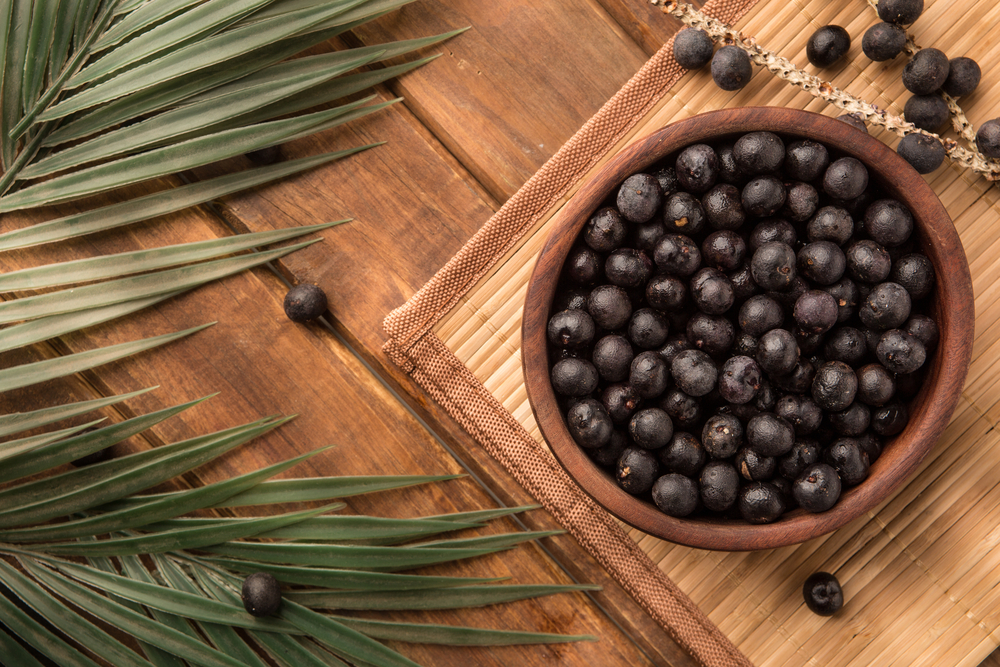ACAI: the health fruit

New Parma / may-june 2009
It is called Açai (botanical name: Euterpe Oleracea) and comes directly from Parà, in the northern side of the Amazon Rainforest (Brazil), the only place where it grows spontaneously – the reason why these palm trees do not produce fruits somewhere else is still a mystery. The Açai is the fruit of a wild palm tree and is very similar to blueberries. It contains an extraordinary amount of fibres, vitamins, mineral salts, antioxidants, omega-6 and omega-9. Recent studies have demonstrated that it is one of the most nourishing and revitalizing foods in nature. After its extreme success in the USA, it is now known as “Super food” or “Nature’s perfect food”, and is considered one of the “functional foods”. Nicholas Perricone, the author of the best-selling “La conquista della bellezza” (The attainment of beauty), suggests the Açai among the ten super foods to buy, since it is rich in anti-oxidants, fibres and mineral salts.
The Açai flesh contains a very high amount of anthocyanins, ten times the anti-oxidants contained in black grapes and up to thirty times the ones contained in a glass of red wine. This helps fighting the cells’ precocious aging. So, the Açai becomes a good substitute for blueberries (widely known as an excellent source of anthocyanins), bearing many similarities in structure and colour (although 80% of the Açai is made of stone), and even in taste. In traditional medicine, moreover, food rich in anthocyanins is often used to treat inflammatory dysfunctions such as arthritis, as well as therapies against circulatory disorders. Thanks to its large amount of anti-oxidants, it helps fighting free-radicals and keeps the cell membranes of the skin and of the muscular tissues free, thus providing a strong anti-aging effect.
New research from Japan suggests that anthocyanins are particularly effective in fighting adipose cells, so they could be useful in preventing weight gain. The studies show that anthocyanins have a strong anti-obesity effect and control the adipocyte functions both in human in-vitro cell cultures and in guinea pigs. Moreover, research has found out that anthocyanins could be useful in preventing the metabolic syndrome (characterised by excess weight, hypertension, carbohydrate intolerance and dislipidemy).
The Açai also contains an extraordinary synergy of mono-unsaturated and poly-unsaturated healthy fats (omega-9 and omega-6), which are extremely useful for the body to fight LDL (which causes cardiovascular diseases). Furthermore, the acids contained in the Açai are very similar to those contained in olive oil. These are very important for the body under many aspects, for example they help omega-3 (contained in fish, especially in salmon) penetrate in the cell membranes, thus making them more flexible. Thanks to this, all the hormones, neurotransmitters and insulin receptors work better, thus reducing the cell aging factors.
Last but not least, the Açai is very rich in hydrosoluble dietary fibres and in phytosterols, which help the digestive and intestinal functions, thus making it a potential anticarcinogenic fruit.
Its richness in hydrosoluble fibres, together with the nourishing properties of the fruit make it a particularly filling fruit, so it can be used in diets. In an old Brazilian recipe used by the Amazon tribes, the Açai is often used with Guarana (also coming from the Amazon Rainforest), which is rich in caffeine and is said to help giving energy and concentration. In fact, it is very used by the people practising Brazilian Ju-Jitzu, Capoeira and other “hard” sports, since it makes the athletes more vigorous and focused.




